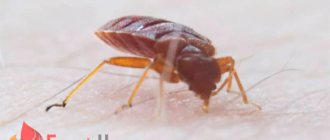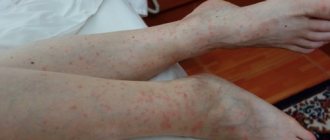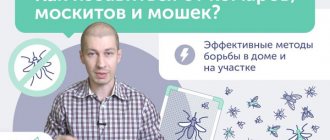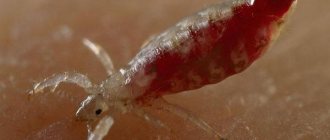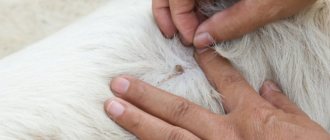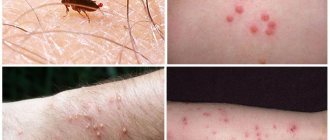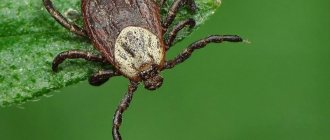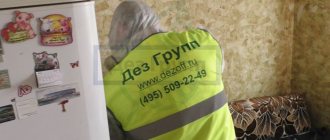Ants are a large group of insects. Their activity is both beneficial and harmful: they destroy pests of cultivated plants and help improve the condition of the soil, but protect aphids from death. In Russia, insects never attack a person unless the latter poses a serious danger. Ant stings are a defensive or offensive tactic of control by injecting toxic chemicals. Formic acid is the insect’s main weapon, which it uses when danger arises. If necessary, it is capable of spraying the substance at a distance of up to 30 cm.
Any actions of ants are aimed at protecting their colony and home. Most often, people are attacked by war ants, which are forced to sacrifice themselves. They are distinguished by powerful jaws and a large head. Sometimes a person is attacked by foragers - working insects that provide the anthill with everything necessary for the life of the colony.
The influence of ants on human life
Ants are certainly useful for nature, as they perform a number of important functions. They are seed distributors, which allows the plant to reproduce. Ants also excellently loosen the soil, which creates favorable conditions for the development of plants and various crops.
However, the life activity of the ant creates interference for humans. If this insect settles in a living room, then food spoils. An ant bite can also cause allergies in humans. Pets are also attacked. It is worth noting the unsanitary conditions in the home.
What do house ants bite?
The numerous species of insects include about 6,000 different families. Their mouthparts are somewhat different, so the question arose of how exactly house ants do this, that in the warm season they appear in the house and crawl in garden plots.
The mouthparts are licking and gnawing. Includes an upper lip, a lower lip, and two pairs of powerful jaws. This is what house ants bite with. The bite itself does not cause much discomfort; it is similar to a mosquito bite. The ant's main weapon is acid. Half of the abdomen is occupied by a poisonous gland. When an insect bites, it injects poison. Formic acid is dangerous for many insects and immobilizes them in a few seconds. For a person in a minimal amount it does not cause harm, and when used wisely it even brings benefits. However, being bitten by a large number of ants increases the risk of an allergic reaction. A bite from a small insect leads to serious consequences.
Description and photo of ant bites
An ant bite causes quite unpleasant painful sensations. This is explained by the fact that during a bite, a small amount of poison enters the skin, which causes redness.
Consider the fact that ants will never attack on their own. They only do this for protection.
The consequences of a bite are unpredictable, as they depend on many factors. However, you can highlight the main things that will happen to you after the bite. After an attack, you may experience burning, pain, and swelling, as well as redness at the site of the bite. All these consequences are amplified if a person has allergies.
Usually, after a few days, all symptoms subside, but in more sensitive people everything can only get worse.
It is important to understand that a bite is a wound, so do not scratch it under any circumstances, as there is a possibility of infection in the wound.
Prevention
It is believed that ants are inactive at night. But it is not so. If insects have settled in the house, then the owners of the home know that there will be no peace. Neither time of day nor seasonality affects pest activity. All that remains is to use traps and insecticides to destroy the uninvited guests. After disinfestation, the apartment must be thoroughly cleaned.
As for safety in nature, you should not rest next to an anthill. When traveling in southern countries, avoid contact with insects and use repellents to treat clothing. When traveling, take antiallergic drugs and external antiseptics with you.
https://www.youtube.com/watch?v=f6MYJl6IPuM
Dear readers of the 1MedHelp website, if you still have questions on this topic, we will be happy to answer them. Leave your reviews, comments, share stories of how you experienced a similar trauma and successfully dealt with the consequences! Your life experience may be useful to other readers.
The body's reaction to an ant bite
As already mentioned, ants bite only for the sake of protection and if they do not feel danger, they will not attack again. This results in a large distance between bites. Most often, bites are observed on those parts of the body that touch the table when you eat and on parts of the body that touch the bed while sleeping.
According to experts, formic acid, which is poisonous and released during a bite, in small doses can only harm allergy sufferers, but if there are really a lot of bites, then there is a danger for ordinary people.
That is why you should always consult a doctor in a timely manner.
Symptoms of ant bites
Allergy sufferers most often experience the following symptoms:
- Heat.
- Headache.
- Dizziness.
- Nausea.
Among the main symptoms are:
- Swollen tongue.
- Slurred speech.
- Loss of consciousness.
If you experience these symptoms, consult your doctor immediately. Remember not to scratch wounds.
Exotic species
There are several dozen dangerous species of ants in the world, living in Asia, Africa and America. The bites of these types of ants are very painful and dangerous. These insects include:
- The nomadic species, called siafu, live in Africa and South America, move in entire colonies in search of food, and are ranked among the largest ants in the world. Outwardly, they look terrifying: with a body size of 1.5 cm, the jaws of the insect grow larger than its head, and female siafus reach 5 cm during the egg-laying period. According to the testimonies of victims, ants bite very painfully, secreting poisonous enzymes, which is why they often allergic consequences occur, but no deaths have been recorded.
- The bullet ant bites even more painfully, since its secretion contains poneratoxin, which is considered one of the most poisonous in the world. According to the victims, the bite of such a “bullet” causes severe pain, comparable to a gunshot wound. Another name for it, “24 hours,” is associated with the duration of the painful condition after the bite. The size of the biting insect reaches 1.5-3 cm (females are always larger), they live in South Africa.
Interesting!
Local residents use the bites of this species of ants during male initiation rites, after which the bitten arms and legs may even be temporarily paralyzed or blackened.
- The bulldog is a small ant, but deadly, causing many deaths in the Pacific Islands every year. The danger is an acute allergic reaction to an ant bite, often leading to a state of shock.
- Red fire ants, whose bites are considered the most poisonous in the world, originally inhabited the South American continent. However, thanks to their high adaptation, they, along with ships, easily moved to Asia, Australia and North America, reaching the southern states of the United States. They are found in Asia and the Pacific Islands. The pain of a red ant bite can be compared to a burn: the insect infects with the poison solenopsin, which causes severe allergic consequences, including the death of a person from anaphylactic shock.
Knowledge about these types of insects and how to treat an ant bite is necessary for all travelers and tourists visiting exotic countries, so that the long-awaited vacation does not end in illness and tragedy.
Treatment of ant bites
In case of a small number of bites, you do not need to contact a specialist. It is enough to take an antihistamine to prevent the development of allergies. It would also be a good idea to apply some soothing gel.
When attacked by ants, it is recommended to perform the following series of actions:
- Leave the area where the ants live. Gently remove them from your body with your hands or tweezers.
- It is necessary to disinfect the affected areas to prevent infection from entering the wound. This can be done even with ordinary hydrogen peroxide.
You should take an antihistamine to prevent allergies from developing.
Tired of fighting pests?
Are there cockroaches, mice or other pests in your dacha or apartment? We need to fight them! They are carriers of serious diseases: salmonellosis, rabies. Many summer residents are faced with pests that destroy crops and damage plants.
In such cases, our readers recommend using the latest invention - the Pest Reject repeller.
It has the following properties:
- Gets rid of mosquitoes, cockroaches, rodents, ants, bedbugs
- Safe for children and pets
- Powered by mains, no recharging required
- There is no addictive effect in pests
- Large area of operation of the device
Read more about it here >>
Folk remedies
It happens that you don’t have the necessary medication on hand to treat bites. Then folk methods come to the rescue:
- Toothpaste has a cooling effect. Apply it to the bite site, and then the itching will go away.
- Echinacea tincture relieves pain and itching well.
- Water along with ammonia works well against ant bites. They should be diluted in a 1:1 ratio.
- Rub the bite area with a cut piece of onion.
- Milk lotion with ice effectively eliminates redness and itching.
- Baking soda is an excellent option for ant bites.
In addition to all of the above, there are simpler options for treating ant bites:
- Raw potatoes.
- Aloe juice.
- Plantain leaf.
- Parsley juice.
Please note that you should not self-medicate if you are not completely sure that your allergy will not manifest itself.
If you delay going to the doctor too long, the situation can change dramatically and then death is possible.
A child was bitten by an ant: what to do?
If your child is bitten by a “harmless” ant, then it does not pose any particular danger. The main thing is to clean the wound, eliminate pain and itching.
- First of all, remove the baby from the ants' habitat. Check to see if there are any other insects on your body, as they can even get under your clothes.
- The bite site should be washed under cool running water. If possible, then let the baby swim or lie in a warm bath. Don't forget to use soap.
- Treat the bite with an antiseptic. Alcohol, peroxide or cologne will do. This will help eliminate itching and relieve redness.
- Do not let your child scratch the bitten area!
Child bitten by an ant
- Apply to the sore spot for 10-15 minutes. ice or any cold compress. This will help relieve swelling.
- It won't hurt to apply aloe juice or tea tree oil to the bitten area. They will help eliminate symptoms, alleviate the condition and additionally disinfect the sore spot. You can also treat with soda or saline solution.
- Be sure to monitor your baby throughout the day, as their skin is thinner and more delicate than that of an adult. Therefore, the reaction can be stronger and faster.
- If any allergic reactions occur, give your baby antihistamines. For example, Claritin or Zyrtex.
Important! If the baby’s condition does not improve or he is an allergy sufferer, be sure to go to the hospital. This also applies to cases when the baby was bitten by an ant in the mouth or was swallowed.
Medical treatments
If you are bitten by an ant, you need to follow fairly simple steps. First, wash the wound with soap and water to disinfect. Next, apply something cold to the affected area to relieve discomfort. Next, you should apply a disinfecting gel.
Here is a list of drugs that act as an antiseptic:
- Fenistil Gel.
- Advantan.
- Gel Gold Star.
- Vitaon.
Of course, these substances should be applied as soon as possible, but please note that this is just first aid, so after completing the steps, be sure to consult a doctor so that he can prescribe a course of treatment for you.
But what to do if an allergic person is bitten?
The most important thing is not to panic.
Call an ambulance.
Provide first aid to the victim. It is important to carefully treat all wounds to prevent infections from entering them.
Make sure that nothing bothers the person. Remove all distractions from it.
Usually, in severe cases, the victim is prescribed treatment with diphenhydramine, which should not be taken by nursing mothers. Steroids may also be prescribed to prevent inflammation.
Also, allergy sufferers should carry a special bag with all the necessary products.
The disadvantage of this bag is that it is bulky and usually takes up a lot of space, but it can save the life of a person with allergies.
Children, as everyone knows, have a very hard time withstanding unpleasant sensations and constantly strive to scratch the wound, which can cause infection to enter the bloodstream. To prevent this, special patches and ointments with a softening effect are suitable.
Danger signs
When delving into what will happen if an ant bites and an allergy begins to appear, you need to understand that there are several degrees of development. The photo shows one of the options for a severe allergic reaction. A mild degree is manifested by itching, redness and swelling of the affected area of the skin. Nausea and sometimes vomiting may occur. A person feels general weakness, nothing more.
However, with a strong response, the following types of allergies are found in a person:
- Hives. It appears as a red rash, which then turns into blisters. In the affected area, a person feels a strong burning sensation and increased temperature.
- Quincke's edema. A type of urticaria in which swelling of the mucous membranes of the eyeballs, larynx and lips is observed. Swelling of the larynx threatens to impair breathing, up to its complete cessation.
- Anaphylactic shock. Occurs due to individual intolerance to a substance contained in the saliva of an ant. Anaphylaxis manifests itself in the form of severe pain, itching and burning, decreased body temperature, paleness, increased sweating (cold sweat), pale skin combined with acrocyanosis (blueness in the lips). There is shortness of breath, difficulty breathing, loss of consciousness. If timely assistance is not provided, the victim may die.
Children endure ant attacks much more severely than adults. They develop red blisters more quickly. You should not allow your child to scratch the affected area, as this increases the risk of tissue infection.
Why do insects bite us?
For no reason, house ant bites will not appear. Pests exhibit particularly aggressive behavior when defending themselves or an anthill. People may not attach importance to redness on the body, but individual tolerance and immunity are different for everyone. Some face serious problems and have to improve their health over a long period of time. If you don’t want to tempt fate, then it’s best to look at photos of domestic ants and compare them with the parasites that have settled in the apartment. Make sure you are not living near an aggressive fire insect that is extremely dangerous to remove yourself.
In the climatic zone of Russia, poisonous ants are quite rare, but one should not lose dexterity and vigilance. The affected area is of no small importance, since delicate epithelium, unlike hardened ones, is more prone to the appearance of rashes. The bite force of a forest ant is greater than that of a house ant, so it is necessary to follow some safety rules when traveling outdoors:
- Choose closed clothing and shoes;
- Do not use perfume or creams with sweet odors that attract insects;
- Check for pests in food before starting a picnic;
- Do not stir up discovered anthills.
When you notice large numbers of red ants at home, it is best to immediately acquire the required amount of insecticides, or immediately turn to professionals. Parasites multiply at lightning speed and soon will not want to leave their favorite territory.


